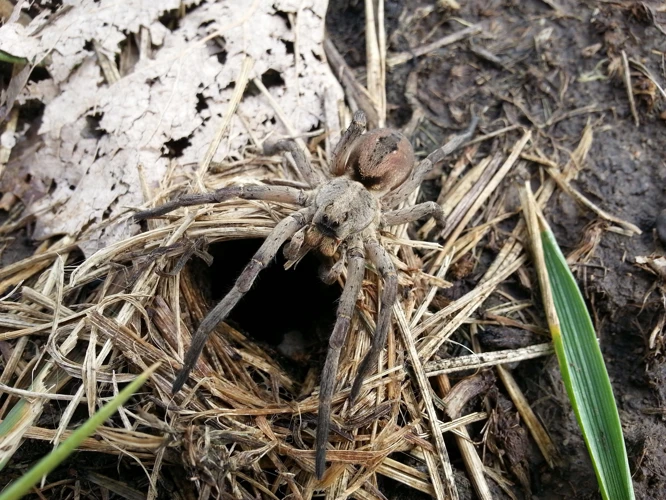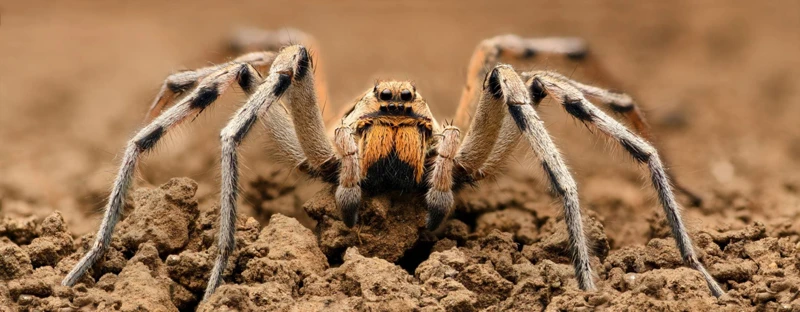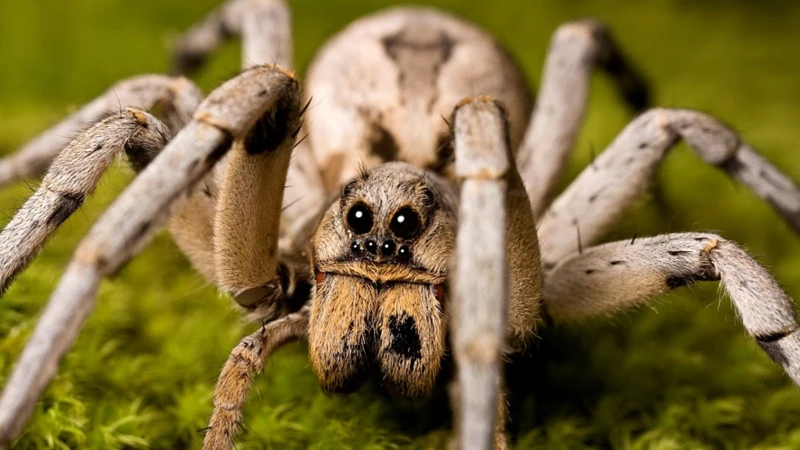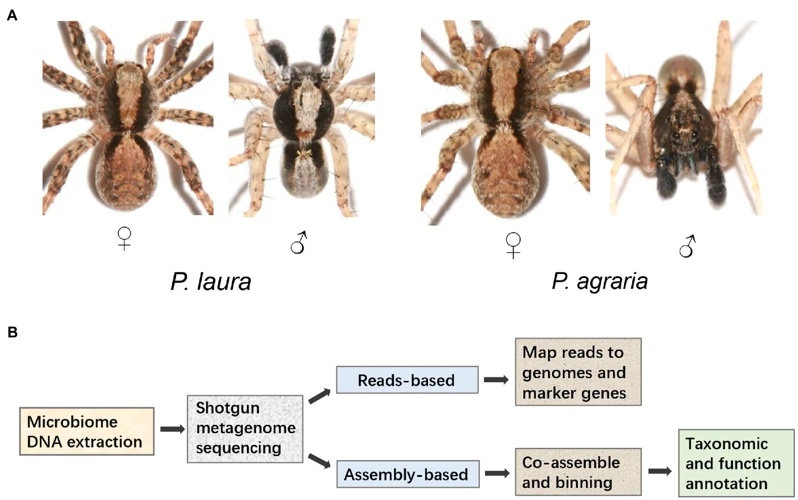As we explore the natural world, it’s hard not to be fascinated by the various species that inhabit different parts of the planet. Wolf spiders, for instance, are a particularly intriguing group of arachnids. They have unique hunting strategies and can be found in diverse habitats around the world. However, have you ever wondered what factors influence their geographical distribution? This is a question that has puzzled scientists for decades. In this article, we will explore the complex interplay of habitat, food availability, human impact, migration and dispersal, and climate change that all contribute to the distribution of wolf spiders. So, let’s delve into this topic and discover the fascinating world of wolf spiders together!
Habitat

The habitat of wolf spiders can play a critical role in determining their geographical distribution. From the ground-dwelling environments they prefer to the availability of moisture and suitable temperatures, many factors come into play. Understanding these factors is essential to identifying where wolf spiders can be found throughout the world. Researchers from around the globe have explored the complex interplay of factors that contribute to the global distribution of wolf spiders, and their findings have been compiled in various scientific studies[1]. In this section, we will explore the highlights of their research on the habitat requirements of wolf spiders, including their preferences for environmental conditions that enable their survival and reproduction.
Preference for Ground-Dwelling Environments
Wolf spiders are known for their preference for ground-dwelling environments. They can be found in a variety of habitats including grasslands, forests, deserts, and wetlands. However, they tend to be more abundant in areas with low-lying vegetation, leaf litter, and soil debris. These environments provide ideal hunting grounds for wolf spiders as they rely on their excellent vision and agility to chase and capture prey.
In fact, wolf spiders are well-adapted to life on the ground. They possess long, spiny legs that enable them to run across various surfaces including rough terrain. Additionally, their bodies are low to the ground which allows them to maneuver easily and quickly.
Numerous studies have shown that wolf spiders are most commonly found in habitats characterized by a complex vegetation structure and high levels of ground cover, and they tend to be absent from areas with sparse vegetation and bare soil. This is partly due to the fact that vegetation provides a suitable microclimate that regulates temperature, humidity, and light intensity which are crucial for the survival of these spiders.
The availability of suitable microhabitats for breeding and egg-laying is closely linked to the preference for ground-dwelling habitats. Wolf spiders typically construct silken retreats in crevices within logs, rocks, and leaf litter on the ground. These retreats serve as a refuge from predators, a site for mate attraction and courtship, and as an egg-laying site.
It is important to note that the presence of wolf spiders is strongly influenced by their habitat preferences. Changes in the vegetation structure or soil moisture can directly affect their abundance and distribution. For instance, deforestation or agricultural activities such as clearing of land can result in the loss of suitable habitat and food resources for wolf spiders, leading to declines in their population.
To learn more about the distribution of wolf spiders in North America, check out our article highlighting their range and diversity. Additionally, explore our article on wolf spiders on different continents, and discover more about the diversity of wolf spiders in the tropics. Finally, read up on mapping wolf spiders in undersudied regions to understand how researchers are uncovering new information on these fascinating creatures.
Need for Moisture
Wolf spiders are known for their ability to adapt to a wide range of environmental conditions. However, one factor that greatly influences their geographical distribution is their need for moisture. Here are some factors that are specifically related to wolf spiders’ need for moisture:
- Hygrophilous Habitats: Wolf spiders are usually found in habitats with high moisture levels such as wetlands, riverbanks, and forests. They are also often found in close proximity to rivers, streams, and other water sources, as they need these sources for hunting and reproduction.
- Mating Behavior: Moisture is particularly important during the mating season, as male wolf spiders create a “mating floor” by secreting a special fluid and then drumming their front legs on the surface to attract females. The substrate needs to be moist enough for this behavior to work.
- Molting and Reproduction: Wolf spiders also require a moist environment for molting and reproduction. Females lay their eggs in a silken sac, which they carry around with them until the eggs hatch. The humidity of the environment is crucial for the survival of the eggs and baby spiders.
- Influence of Climate Change: Climate change can greatly affect wolf spiders’ need for moisture. As temperatures rise, habitats that were once moist and suitable for wolf spiders may become dry and inhospitable. This can force the spiders to migrate to more suitable locations or lead to a decline in population size in certain areas.
Moisture is a crucial factor that influences the geographical distribution of wolf spiders. Their ability to adapt to changes in moisture levels is key to their survival, and factors like climate change can greatly impact their populations.
Temperature and Altitude
The preferred temperature range for wolf spiders varies based on their species and geographic location. Generally, they are found in areas with moderate temperatures ranging from 10°C to 30°C. However, some species, such as the Arctic wolf spider, are adapted to colder climates and can survive in temperatures as low as -25°C.
Altitude also plays a crucial role in wolf spider distribution. Some species are limited to specific elevations, while others are found in a range of altitudes. For example, the Pardosa saltuaria is a lowland species and is typically found at elevations below 1000m. On the other hand, the Hogna radiata can be found at elevations up to 3000m.
To understand the relationship between temperature, altitude, and wolf spider distribution, we can examine the following table:
| Temperature Range (°C) | Elevation Range (m) | Example Species |
|---|---|---|
| 10-30 | Sea level to 3000m | Arctosa leopardus |
| 0-20 | Sea level to 850m | Geolycosa vultuosa |
| -25 to 15 | 2000m to 4000m | Pardosa saltuaria |
| 10-20 | Sea level to 1000m | Wadicosa trilobata |
This table shows the preferred temperature ranges and elevations for four different species of wolf spiders. As we can see, each species has adapted to a specific temperature and altitude range. For example, the Arctosa leopardus can be found in a wide range of temperatures and elevations, while the Pardosa saltuaria is adapted to colder temperatures and higher elevations.
The temperature and altitude ranges selected by the wolf spiders depend on their adaptive abilities towards weather changes over time.
Food Availability

The ability of wolf spiders to thrive in different environments can be greatly influenced by the availability of food they can find. In their search for prey, wolf spiders rely on their keen senses and hunting instincts to catch a variety of insects and other small animals. But what factors determine their success in finding and consuming enough food for their survival? Let’s explore some of the key considerations that influence the food availability for wolf spiders.
Relevance of Prey Size and Abundance
Wolf spiders are known to feed on a wide variety of prey, ranging from small insects and other arthropods to larger invertebrates like earthworms, snails, and even small vertebrates. The size and abundance of prey can significantly influence the distribution of wolf spider populations in a given area.
1. Availability of Prey
The abundance of prey species in a particular habitat can determine the density of wolf spider populations. In areas where there is an ample supply of prey, such as in forests with high insect diversity, wolf spiders are likely to thrive. However, in areas with scarce prey, such as deserts or areas that have been heavily impacted by human activity, wolf spider populations may struggle to survive.
2. Size of Prey
The size of prey can also affect the distribution of wolf spider populations. Larger prey can provide more energy and nutrients to wolf spiders, allowing them to grow larger in size and produce more offspring. Habitats with larger prey, such as small mammals or birds, may be more attractive to wolf spiders.
3. Competition with Other Predators
The presence of other predators can also influence the distribution of wolf spiders. In areas with high competition from other predators, such as birds or other spider species, wolf spider populations may be limited. In contrast, areas with low competition may allow wolf spider populations to expand.
4. Adaptations to Prey
Wolf spiders have evolved a range of adaptations that allow them to capture and consume a wide variety of prey species. For instance, some wolf spiders are adapted to burrow and hunt underground, while others hunt actively on the surface. These adaptations may enable wolf spiders to exploit different resources and thrive in diverse habitats.
5. Role in Ecosystem
Wolf spiders play a crucial role in many ecosystems as both predators and prey. They are known to consume a range of pest species, including mosquitoes, flies, and beetles, and can help limit the populations of these pests in agricultural and urban areas. At the same time, they are important prey species for many larger predators, including birds, lizards, and small mammals.
The relevance of prey size and abundance is a significant factor influencing the distribution of wolf spider populations. The abundance of prey, the size of prey species, competition with other predators, adaptations to prey, and their role in the ecosystem can all play a significant role in determining the distribution of wolf spider populations. By understanding these factors, researchers and conservationists can better protect and manage wolf spider populations and their associated ecosystems.
Competition and Predation
Competition and predation are two key factors influencing the distribution of wolf spiders. These spiders face intense competition for resources, such as food and shelter, from other spider species as well as from other predators.
Competition: Wolf spiders are known to be aggressive predators and thus compete with other spider species for resources. For instance, in areas where spiders have to hunt for specific kinds of prey, there is competition among different spider species for the same food source. In such areas, wolf spiders have to fight to get their prey, which can lead to reduced populations that cannot sustain them.
Predation: Wolf spiders are also at risk of becoming prey to other larger predators such as birds and rodents. This can significantly influence the distribution of wolf spider populations. For instance, areas with high bird populations could have low wolf spider populations due to predation.
Competition and predation are significant factors that can influence the distribution of wolf spiders. While they are strong predators themselves, the need to compete for resources with other spider species and avoid predation by larger predators can significantly impact their population size in a given area.
Here is a table summarizing the effects of competition and predation:
| Competition | Predation | |
|---|---|---|
| Impact on wolf spider populations | Reduces populations in areas with intense competition for resources | Reduces populations in areas with high predator populations |
| Effects on distribution | Competition with other spider species can influence which areas wolf spiders inhabit | Predation can limit the areas where wolf spiders can survive |
Human Impact

As much as human civilization has advanced, it has also brought disastrous consequences to the natural world. Sadly, the habitat of many species of wildlife is constantly shrinking due to human activities. The same can be said for wolf spiders, as they too have not been immune to human impact. The factors affecting the geographical distribution of wolf spiders now also include the devastating effect of human influence. This calls for an in-depth analysis of the various human factors contributing to the diminishing range of these fascinating creatures. Let’s explore these factors further.
Effect of Urbanization and Habitat Fragmentation
Urbanization and habitat fragmentation are two interconnected factors affecting the distribution of wolf spiders. With the increasing human population, urban areas have been expanding, leading to the destruction of natural habitats and fragmentation of ecosystems. This has resulted in the loss of suitable habitats for wolf spiders, which impacts their distribution.
Habitat fragmentation occurs when a large habitat or ecosystem is divided into smaller and isolated fragments due to human activities such as agriculture, mining, and construction. As a result, wolf spider populations become isolated, leading to reduced genetic diversity and a higher risk of local extinctions. This, in turn, affects the overall distribution of wolf spiders in an area.
A study published in the journal “Ecography” revealed that urbanization and habitat fragmentation have a significant impact on the distribution of wolf spiders. The study found that wolf spider populations were more abundant in natural habitats and undisturbed areas, while the urbanized areas had fewer populations of wolf spiders.
Table: Impact of Urbanization and Habitat Fragmentation on Wolf Spiders
| Factors | Effect on Wolf Spiders |
|---|---|
| Urbanization | Reduction in suitable habitats |
| Habitat Fragmentation | Isolation of populations |
| Loss of Connectivity | Increased risk of local extinctions |
In addition to habitat loss and fragmentation, urbanization and human activities also lead to other impacts that affect wolf spiders’ distribution. Pesticide use, construction work, and vehicle traffic are additional human activities that can negatively impact the wolf spiders’ distribution. These activities introduce pollutants and toxins into wolf spiders’ environments, which can accumulate in their tissues and lead to health problems.
Urbanization and habitat fragmentation have played a significant role in influencing the distribution of wolf spiders. These factors have resulted in the loss of suitable habitats and fragmentation of ecosystems, leading to a decline in wolf spider populations in urban areas. Conservation efforts that protect natural habitats and promote connectivity between fragmented ecosystems are crucial for ensuring the survival and distribution of wolf spiders.
Bioaccumulation and Toxicity
As human activities continue to expand into natural areas, wolf spiders face increasing exposure to pollutants and chemicals. Some of these substances can accumulate in the bodies of these arachnids, a process known as bioaccumulation, which has harmful effects on their health and reproductive success.
Heavy metals such as cadmium, lead, and mercury are particularly concerning as they can persist in the environment for long periods and have toxic effects on wolf spiders. These metals can enter the spiders’ bodies through direct contact with contaminated soil or prey, and can cause genetic damage, impaired development, and reduced fertility.
Pesticides are another cause for concern. Wolf spiders can be exposed to these chemicals through both direct contact and ingestion of contaminated prey. Pesticide exposure has been linked to reduced activity levels, malformed genitalia, and decreased survival rates for wolf spiders.
Other chemical pollutants such as polychlorinated biphenyls (PCBs) and polycyclic aromatic hydrocarbons (PAHs) have also been detected in wolf spider populations. These substances can interfere with the spiders’ hormone systems and have been linked to developmental abnormalities and reduced immune function.
It’s important for humans to understand the potential harm of these pollutants and take steps to reduce their overall impact on the environment. Implementing sustainable agricultural practices, reducing pesticide use, and properly disposing of hazardous waste are all ways in which we can help to safeguard the health and wellbeing of wolf spiders and other wildlife.
| Substance | Harmful Effects |
|---|---|
| Heavy metals (e.g. cadmium, lead, mercury) | Genetic damage, impaired development, reduced fertility |
| Pesticides | Reduced activity levels, malformed genitalia, decreased survival rates |
| Chemical pollutants (e.g. PCBs, PAHs) | Interference with hormone systems, developmental abnormalities, reduced immune function |
Migration and Dispersal
As wolf spiders are known for their nomadic tendencies, migration and dispersal are key factors that play a role in shaping their geographical distribution. These arachnids are widely distributed across the globe and have the ability to adapt to different environments, which allows them to move across distances in search of food and resources. Understanding the nuances of their migratory patterns and dispersion mechanisms is crucial in predicting their distribution and population dynamics. Let’s delve deeper into how migration and dispersal shape the distribution of wolf spiders.
Distances and Barriers
The geographical distribution of wolf spiders is greatly influenced by their ability to migrate and disperse across different regions. However, distances and barriers can pose significant challenges to these spiders.
Distance: Wolf spiders are capable of covering long distances to search for new habitats, with some species capable of travelling up to 10 km in a single night. However, long distances can prove to be a major challenge for juvenile spiders and those with limited energy reserves. They may face difficulty in crossing vast expanses of open land or large bodies of water which can isolate populations and hinder gene flow.
Barriers: Barriers can refer to both natural and man-made obstacles that restrict the ability of these spiders to migrate and disperse. For instance, mountainous terrain and deep valleys can make it difficult for wolf spiders to cross from one region to another. Similarly, dense forests and arid deserts can also pose challenges as it can be challenging for these arachnids to traverse such terrains. In addition to natural barriers, human-made barriers such as roads, highways, and other infrastructure can also fragment the habitats of these creatures, reducing the mobility and gene flow between different populations, ultimately leading to population decline and genetic isolation.
Distances and barriers can significantly influence the geographical distribution of wolf spiders. While some species are capable of covering vast distances, others may struggle with mobility issues, and natural and human-made barriers can pose significant challenges to their survival. It is essential to consider these factors when assessing the impact of habitat fragmentation and climate change on the population dynamics of these fascinating creatures.
Role of Climate Change
Climate change has been identified as a major driver of species distribution shifts and range changes. The effects of climate change on wolf spider populations are complex and not yet fully understood. However, some studies suggest that changes in temperature and precipitation patterns could impact the distribution and abundance of wolf spiders.
Table:
| Climate Factor | Potential Impact on Wolf Spider Distribution |
|---|---|
| Temperature | Long-term increases in temperature could expand the range of some wolf spider species, while others may be restricted to smaller ranges or be forced to move to higher elevations to maintain suitable habitats. |
| Precipitation | Changes in precipitation patterns could affect the availability of plant and prey resources, which could have indirect effects on wolf spider populations. Changes in surface moisture levels could also affect the availability of microhabitats where wolf spiders find shelter. |
| Extreme Weather Events | Events such as droughts, floods, and wildfires could impact wolf spider populations directly by destroying habitats and indirectly by affecting prey availability. |
As mentioned earlier, wolf spiders are ground-dwelling predators that rely on vegetation and soil moisture for shelter and reproduction. In the event of prolonged droughts or extreme weather events, the loss of vegetation could lead to decreased soil moisture and reduced prey availability, which could have devastating effects on wolf spider populations.
Another concern is that the rapid pace of climate change may outstrip the adaptive capabilities of wolf spiders and other species, leaving them vulnerable to extinction. With warming temperatures and altered precipitation patterns, wolf spiders may also encounter new competitors or predators and face additional challenges in finding suitable habitats for survival.
While more research is needed to fully understand the impact of climate change on wolf spiders, it is clear that their distribution and survival are closely tied to environmental conditions. The role of climate change in shaping the geographical distribution of wolf spiders underscores the need for continued monitoring and conservation efforts to ensure the persistence of these remarkable arachnids.
Conclusion
After examining the various factors that influence the geographical distribution of wolf spiders, it becomes clear that they are highly adaptable creatures that can thrive in a range of environments.
Habitat: Wolf spiders prefer ground-dwelling environments that are moist and cool. They are sensitive to changes in temperature and altitude, and can only survive in areas that meet their specific needs.
Food Availability: The availability of prey is essential for the survival of wolf spiders. The size and abundance of prey, as well as competition and predation, all play a role in determining their distribution.
Human Impact: Human activity has a significant impact on the distribution of wolf spiders. Urbanization and habitat fragmentation, as well as bioaccumulation and toxicity, all have negative effects on their populations.
Migration and Dispersal: The ability of wolf spiders to migrate and disperse is essential to their long-term survival. However, distances and barriers as well as climate change can hinder these abilities.
In conclusion, the geographical distribution of wolf spiders is influenced by a complex interplay of factors including their habitat preferences, food availability, human impact, and migration ability. Continued research and conservation efforts are needed to ensure the long-term survival of these fascinating creatures.
Frequently Asked Questions
What kind of habitats do wolf spiders prefer?
Wolf spiders prefer ground-dwelling environments that are moist and have cover.
Why do wolf spiders need moisture?
Wolf spiders need moisture in order to survive and reproduce, as it is important for maintaining their body temperature and overall health.
What factors are important in determining wolf spider distribution in terms of temperature and altitude?
Temperatures and altitude are important factors that impact the distribution of wolf spiders, as different temperatures and altitudes can either be too hot or too cold for them to thrive in. They are typically found in areas with moderate temperatures and lower altitudes.
What role does prey size and abundance play in wolf spider distribution?
The availability of prey and its size is an important factor in wolf spider distribution, as they rely heavily on a steady food supply to survive and reproduce. Areas with high prey abundance and diversity are likely to have higher wolf spider populations.
How does competition and predation affect wolf spider populations?
Competition for resources such as prey, as well as predation from other animals, can impact wolf spider populations and distribution. If there are too many predators or competition for resources is too high, wolf spider populations may decline.
What is the effect of urbanization and habitat fragmentation on wolf spider populations?
Urbanization and habitat fragmentation can impact wolf spider populations, as it disrupts their natural habitat and can lead to habitat loss. This reduction in suitable habitats can lead to a decline in the overall population.
What is bioaccumulation and how does it affect wolf spiders?
Bioaccumulation is the accumulation of toxic substances in an organism. This affects wolf spiders negatively, as they are lower on the food chain and can accumulate toxins from their prey, which can ultimately lead to illness or death.
What barriers and distances affect wolf spider migration and dispersal?
Physical barriers such as mountains, rivers, and oceans can limit wolf spider migration and dispersal. The distance between habitats and the availability of suitable habitats also play a role in their movement.
How does climate change impact wolf spider populations?
Climate change affects the temperature and moisture levels of environments, which are important factors for wolf spider survival and reproduction. If the climate changes too much, it can negatively impact wolf spider populations.
What is the significance of understanding wolf spider migration and dispersal?
Understanding wolf spider migration and dispersal is important for conservation efforts, as it helps to identify important habitat corridors and areas that are essential for their survival. This information can be used to develop effective conservation strategies.







